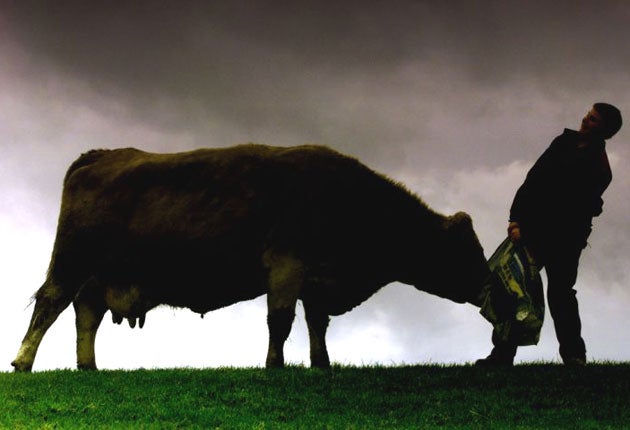Intensive farming and market forces blamed for reckless practices

Intensified farming can create the perfect conditions for disease to spread and for animals to become more susceptible to illness, campaigners warn.
And as disease sweeps through a farm or the animals become less resistant to illness, farmers find themselves using more antibiotics to keep their livestock healthy.
Michael Stacey is now an organic dairy farmer, but, before changing his production methods, he found himself under the same pressures that many conventional farmers now feel.
Pressure from other parts of the supply chain, particularly supermarkets, to keep prices down is one of the chief factors in driving farmers to demand ever more from their animals.
"You are faced by price pressure for herds to get larger and larger," he said. "That puts more stress on the animals. You can counteract that by good management but you are steadily increasing the animals' stress levels. That's going to lead to more disease. Inevitably there are price pressures. That's just a matter of fact in farming."
More diseases among livestock mean farmers need to resort to antibiotics more frequently, but it is not just sickness levels that drive the use of such drugs, he said. Mr Stacey, who has 80 dairy cattle at Gorsehill Abbey Farm in Worcestershire, said there can be peer pressure to use antibiotics in certain circumstances, such as with mastitis after calving.
"We've been organic for some time and we haven't used any antibiotics whatsoever in the last 12 months," he said. "When I first started farming we were treating our cows quite regularly with antibiotics as being the 'right thing to do'.
"There's continual pressure on you to use not just antibiotics but all sorts of additives. There's a lot of industry making money out of that. It's put forward as the right thing to do and that it's most unlikely you will survive if you don't."
Campaigners point to two main reasons for intensification leading to greater use of the drugs. Phil Brooke, of Compassion in World Farming, said the "vast majority" of antibiotics used on farms are given to pigs and poultry.
The number and proximity to each other of animals, such as battery chickens, kept in sheds, is a prime reason for intensive farming needing antibiotics, he said.
"The animals are more crowded together and there are larger numbers of them. These are the conditions that are most likely to spread disease, even if the farms maintain that they have biosecurity measures to stop the disease getting in."
In these circumstances, he said, there is the added problem of farmers giving antibiotics to all the animals in the shed rather than just those displaying signs of disease. In this way the spread is limited and it is cheaper than having to get the vet in several times to dose different batches of animals. "Many farm animals spend 20 per cent of their lives on antibiotics," he said.
The second reason is that intensification also puts more stress on animals. As they are bred to produce to their maximum possible, whether milk, meat or eggs, they could become less able to fight off disease as their immunity becomes compromised.
Bill Reilly, of the British Veterinary Association, said: "I would accept that there has been an increased use in antibiotics, but where we are very clear in the veterinary profession is to use antibiotics responsibly.
"The first line of treatment shouldn't be the modern generation of antibiotics. The more traditional, well-used types should be used first. It's only if animals don't respond to treatment that these should be used. There has to be clinical need."
The spread of antibiotic-resistant superbugs
E.coli
The recent outbreak, thought to have originated in Germany, was found to be a previously unseen and more virulent variant of the bacterium. The O104 strain was described by Stephen Smith, a clinical microbiologist at Trinity College, Dublin, as a "mongrel" combination. Chinese scientists found the strain to be resistant to eight classes of antibiotics. The outbreak killed at least 39 people, and infected 3,300 across 10 countries.
MRSA
MRSA is a drug-resistant form of a usually harmless bacterium which can be deadly when it infects wounds. A new strain of MRSA was discovered in British milk earlier this month. Virtually all milk sold in Britain is pasteurised, meaning the main health concern was not that it would be passed through the milk, but that those who work on farms could pass it to the wider community.
Neisseria gonorrhoeae
The bacteria that causes gonorrhoea is known to develop resistance to antibiotics very quickly. Between 2003 and 2005, the standard treatment for gonorrhoea, ciprofloxacin, was replaced with a newer class of antibiotics – cephalosporins. In 2010, gonorrhoea developed resistance to cephalosporin, the last STD antibiotic left. Doctors are now using less effective drugs to which there is no resistance.
Subscribe to Independent Premium to bookmark this article
Want to bookmark your favourite articles and stories to read or reference later? Start your Independent Premium subscription today.

Join our commenting forum
Join thought-provoking conversations, follow other Independent readers and see their replies